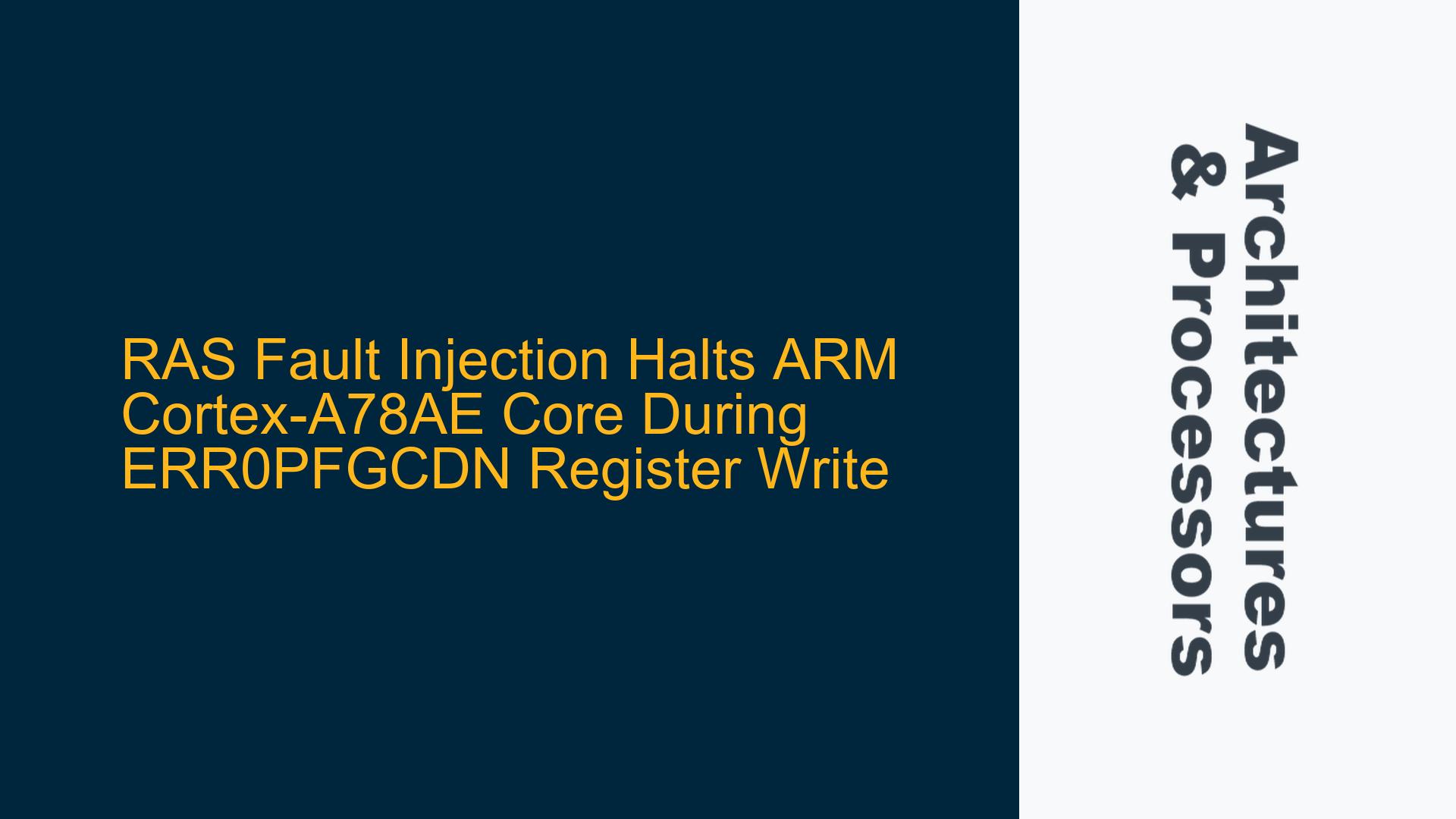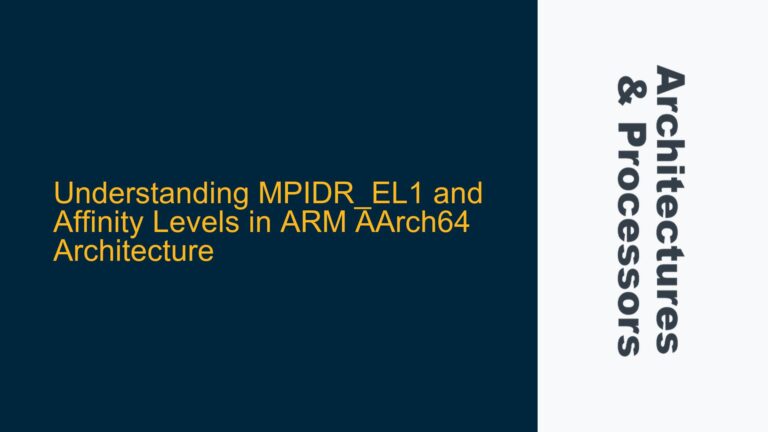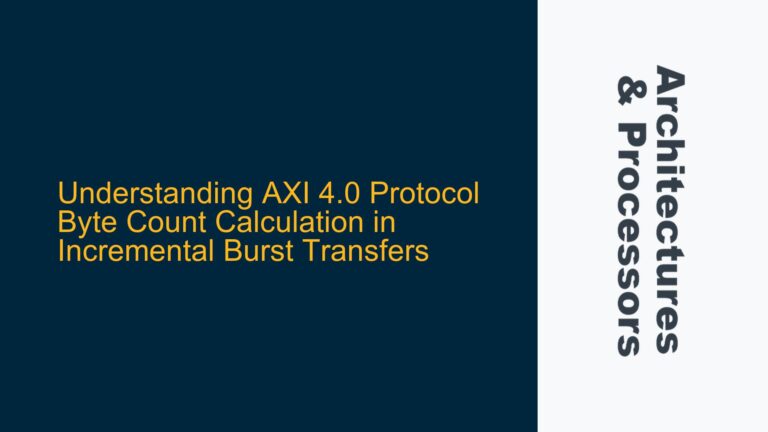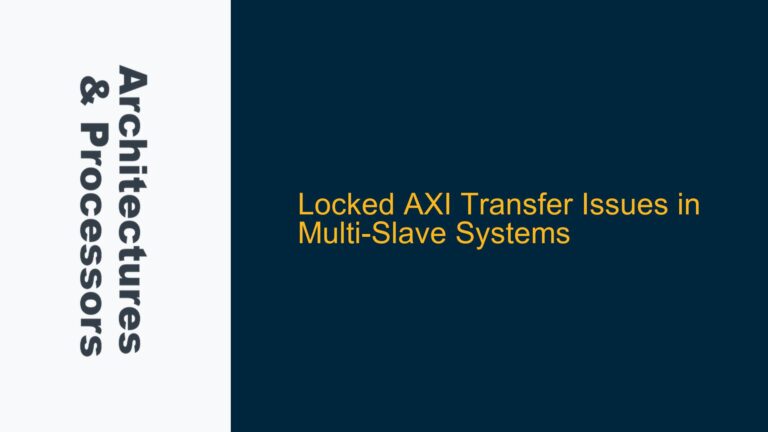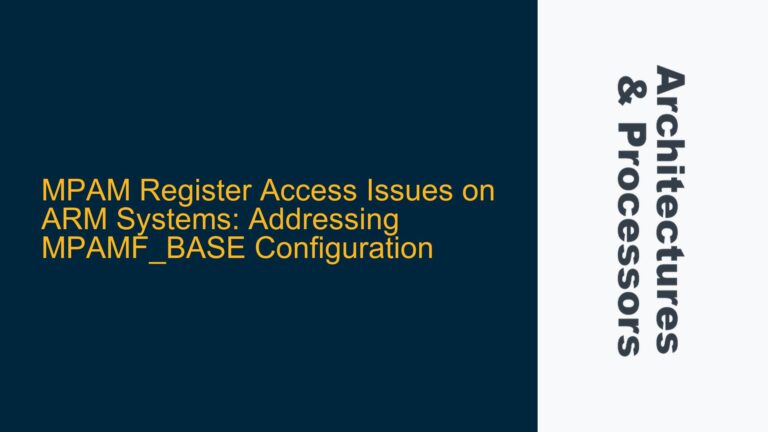ARM Cortex-A78AE Core Halts During ERR0PFGCDN Register Configuration
The ARM Cortex-A78AE core is designed with Reliability, Availability, and Serviceability (RAS) features to enhance fault tolerance and error handling in safety-critical applications. One of the key components of the RAS framework is the ability to inject faults for testing and validation purposes. However, during the configuration of the ERR0PFGCDN register (Error Fault Injection Countdown Register), the Cortex-A78AE core halts unexpectedly, requiring a system restart. This issue arises when attempting to write to the ERR0PFGCDN register using the msr instruction in a Linux kernel module. The specific assembly code used to write to the register is as follows:
asm volatile("mov x0, 0x1");
asm volatile("msr S3_0_C15_C2_2, x0");
Here, S3_0_C15_C2_2 is the encoding for the ERR0PFGCDN register. The core halts immediately after executing the msr instruction, indicating a potential violation of the RAS fault injection protocol or an incorrect configuration of the register. This behavior is critical to diagnose, as it prevents the validation of fault injection mechanisms, which are essential for ensuring the robustness of safety-critical systems.
Incorrect RAS Fault Injection Protocol or Register Configuration
The halting of the Cortex-A78AE core during the write operation to the ERR0PFGCDN register can be attributed to several potential causes. These causes are rooted in the intricacies of the RAS fault injection mechanism and the specific requirements for configuring the ERR0PFGCDN register.
Misalignment with RAS Fault Injection Protocol
The RAS fault injection mechanism in the Cortex-A78AE core is governed by a strict protocol that must be followed to ensure correct operation. The protocol includes prerequisites such as enabling fault injection, configuring fault injection parameters, and ensuring that the core is in a state where fault injection is permissible. Writing to the ERR0PFGCDN register without adhering to this protocol can result in undefined behavior, including core halts. Specifically, the ERR0PFGCDN register is used to set the countdown value for fault injection, and writing to it without enabling the fault injection mechanism or configuring other related registers may trigger a fault condition that halts the core.
Incorrect Privilege Level or Execution Context
The ERR0PFGCDN register is a system register that requires specific privilege levels for access. In the ARMv8 architecture, system registers are typically accessed at EL1 (Exception Level 1) or higher. If the write operation to the ERR0PFGCDN register is attempted at an insufficient privilege level or in an incorrect execution context (e.g., user mode or an unsupported exception level), the core may halt as a protective measure. Additionally, the use of the msr instruction in a Linux kernel module does not guarantee the correct privilege level if the module is not properly configured or if the execution context is not validated.
Unsupported or Incorrect Register Encoding
The encoding S3_0_C15_C2_2 corresponds to the ERR0PFGCDN register, but incorrect usage of this encoding can lead to core halts. The ARM architecture defines specific encodings for system registers, and any deviation from these encodings can result in undefined behavior. If the encoding is incorrect or unsupported for the specific Cortex-A78AE implementation, the core may halt when attempting to access the register. Additionally, the Cortex-A78AE core may have specific requirements for accessing the ERR0PFGCDN register, such as enabling certain features or configuring related registers before accessing it.
Cache Coherency and Memory Synchronization Issues
The Cortex-A78AE core employs a sophisticated cache hierarchy and memory synchronization mechanisms to ensure data consistency. When writing to system registers like ERR0PFGCDN, it is essential to ensure that the core’s cache and memory subsystems are in a consistent state. Failure to issue appropriate memory barriers or cache maintenance operations before writing to the ERR0PFGCDN register can result in inconsistent state, leading to core halts. This is particularly relevant in a multi-core environment where cache coherency must be maintained across cores.
Validating RAS Protocol and Implementing Correct Register Configuration
To resolve the issue of the Cortex-A78AE core halting during the write operation to the ERR0PFGCDN register, a systematic approach is required. This approach involves validating the RAS fault injection protocol, ensuring correct privilege levels and execution context, verifying register encodings, and addressing cache coherency and memory synchronization issues.
Enabling Fault Injection Mechanism and Configuring Prerequisites
Before writing to the ERR0PFGCDN register, it is essential to enable the fault injection mechanism and configure all prerequisites as specified in the Cortex-A78AE RAS documentation. This includes enabling fault injection in the appropriate control registers, configuring fault injection parameters, and ensuring that the core is in a state where fault injection is permissible. The following steps outline the process:
-
Enable Fault Injection: Set the appropriate bits in the fault injection control registers to enable fault injection. This typically involves writing to registers such as
ERR0PFGCTLR(Error Fault Injection Control Register) to enable fault injection and configure the fault injection mode. -
Configure Fault Injection Parameters: Set the fault injection parameters, including the type of fault to inject, the target resource, and the fault injection timing. This may involve writing to additional registers such as
ERR0PFGSELR(Error Fault Injection Select Register) andERR0PFGCTLR. -
Verify Core State: Ensure that the core is in a state where fault injection is permissible. This may involve checking the core’s execution state, exception level, and other relevant conditions.
Ensuring Correct Privilege Level and Execution Context
To access the ERR0PFGCDN register, the execution context must be at the appropriate privilege level (EL1 or higher). The following steps ensure that the write operation is performed in the correct context:
-
Validate Privilege Level: Ensure that the Linux kernel module is executing at EL1 or higher. This can be verified by checking the current exception level using the
CurrentELsystem register. -
Configure Kernel Module: Ensure that the Linux kernel module is configured to execute at the required privilege level. This may involve setting the appropriate permissions and privileges in the module’s configuration.
-
Use Correct Assembly Instructions: Use the
msrinstruction to write to the ERR0PFGCDN register, ensuring that the instruction is executed in the correct context. The following assembly code demonstrates the correct usage:asm volatile("mov x0, 0x1"); asm volatile("msr S3_0_C15_C2_2, x0");
Verifying Register Encoding and Cortex-A78AE Specific Requirements
The encoding S3_0_C15_C2_2 must be verified against the Cortex-A78AE documentation to ensure that it corresponds to the ERR0PFGCDN register. Additionally, any Cortex-A78AE specific requirements for accessing the register must be addressed:
-
Verify Register Encoding: Cross-reference the encoding
S3_0_C15_C2_2with the Cortex-A78AE documentation to ensure that it correctly identifies the ERR0PFGCDN register. -
Check Cortex-A78AE Specific Requirements: Review the Cortex-A78AE documentation for any specific requirements for accessing the ERR0PFGCDN register, such as enabling certain features or configuring related registers.
Addressing Cache Coherency and Memory Synchronization
To ensure that the core’s cache and memory subsystems are in a consistent state when writing to the ERR0PFGCDN register, appropriate memory barriers and cache maintenance operations must be issued:
-
Issue Memory Barriers: Use the
dsb(Data Synchronization Barrier) andisb(Instruction Synchronization Barrier) instructions to ensure that all previous memory operations are completed before writing to the ERR0PFGCDN register. The following assembly code demonstrates the usage of memory barriers:asm volatile("dsb sy"); asm volatile("isb"); -
Perform Cache Maintenance: If necessary, perform cache maintenance operations to ensure that the cache is in a consistent state. This may involve invalidating or cleaning specific cache lines.
Example Implementation
The following code snippet demonstrates the correct implementation of the steps outlined above:
// Enable fault injection and configure prerequisites
enable_fault_injection();
configure_fault_injection_parameters();
// Ensure correct privilege level and execution context
validate_privilege_level();
configure_kernel_module();
// Verify register encoding and Cortex-A78AE specific requirements
verify_register_encoding();
check_cortex_a78ae_requirements();
// Address cache coherency and memory synchronization
asm volatile("dsb sy");
asm volatile("isb");
// Write to the ERR0PFGCDN register
asm volatile("mov x0, 0x1");
asm volatile("msr S3_0_C15_C2_2, x0");
By following these steps, the issue of the Cortex-A78AE core halting during the write operation to the ERR0PFGCDN register can be resolved, enabling successful fault injection for RAS validation.
